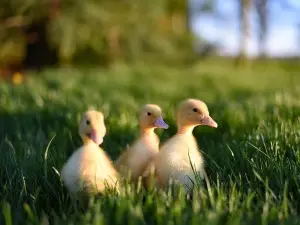
Healthy ducklings are the happiest ducklings, so, if your bird starts showing signs of illness or signs of being in distress then the bird is likely not feeling too good.
A baby duck throwing its head back is a sign of distress, this article will explore everything you need to know about why the baby duck is doing this and what to do
Table of Contents
Baby duck throwing head back:
A baby duck throwing its head back may make you think that the bird is paralyzed but this isn’t the case. The baby bird likely simply has wry neck.
Here is what you need to know about this condition:
What is wry neck?
Wry neck is a condition that can develop in ducks and a variety of other birds.
This ailment is also called stargazing or crook neck because it makes affected birds look like they are forever looking up at the stars, or that the bird’s neck is crooked.
The bird’s head is thrown back because the bird’s neck cannot support the weight of the head and this makes the head fall back.
This ailment will progressively get worse, the ailment can progress from birds having their head thrown back to birds falling onto their back and lying on their backs without the ability to get up.
This can not only be distressing to your bird but it can be debilitating as well. The birds will eventually not be able to eat or drink and will as a result become very dehydrated and even starve to death.
What causes wry neck?
Wry neck can develop in birds who have a vitamin B1 or vitamin E deficiency in their diet, it can develop in ducks if the bird had an injury to its head, if the bird has a genetic disorder, if the bird has botulism or if the bird ingested toxins.
You’d have to retrace the bird’s steps to look for injuries or ingestion of toxins, as well as have a look at the bird’s diet to see if it has a nutrient deficiency.
How to treat wry neck:
Before treating the bird of its wry neck you’d need to first separate this bird from the rest of its flock members.
If you don’t separate the bird then the bird can risk being stepped on by other birds if it falls down, or the bird will risk being pecked if the other birds realize that the bird is ill.
Give the bird access to its own food and water while in isolation. You may need to hand-feed the bird if it can’t seem to feed itself.
Also, keep the bird’s stress levels low while the bird is recovering.
Treatments:
Treatment options will depend on the cause of the bird’s wry neck. If the bird’s diet is lacking in vitamin B1 then this needs to be supplemented, if the bird’s diet is lacking in vitamin E then this would need to be supplemented
If you’re giving birds vitamin E supplements then you would also need to add selenium into the bird’s diet to help the vitamin E absorb more effectively
Adding natural sources of these vitamins in the bird’s diet is recommended over giving the bird supplements, but supplements can also be given to the bird.
Natural sources of vitamin E include chives, coriander, thyme, rosemary, parsley, mint, bay, sage, tarragon, dill, oregano, basil, alfalfa, spinach, rose hips, dandelion, nettle, raspberry leaf, sunflower seeds, pumpkin seeds, and olive soil.
Sources of vitamin B1 that you can give to ducklings include vitamin supplements, brewers yeast, sunflower seeds, bran, and wheat germ.
This isn’t an ailment that you can quickly cure but the bird should get better after taking its treatment consistently
Help the bird’s neck stay up:
The bird’s neck won’t be able to keep the bird’s head up, you’d need to help with this. This is how to safely support the birds head:
Step 1: Get ahold of a clean and fresh cellulose sponge and create a hole in the center big enough for the bird’s head to fit into
Step 2: Get the sponge moist by dripping it in water and wringing it out
Step 3: Get the sponge onto the bird’s head, and put it on as though you are putting a shirt on the bird. Cut the sponge if necessary if the sponge is too large for the bird.
Leave this sponge on the bird’s neck to help support the bird’s neck.
How to prevent wry neck:
Prevention is better than cure and you can easily prevent this ailment from developing in your ducklings in the future.
Prevention looks like making sure that the bird gets enough vitamin B1 and vitamin E in their diet as well as making sure that the bird doesn’t ingest toxins or become injured.
If you enjoyed this article then you may also be interested in other duck related articles. Here are some articles that you may be interested in: How Does A Mother Duck Feed Her Ducklings?, Why Do Mother Ducks Kill Their Babies?, Why Do Ducklings Follow Their Mother?, Duckling Wobbly, Duckling Laying On Its Back

